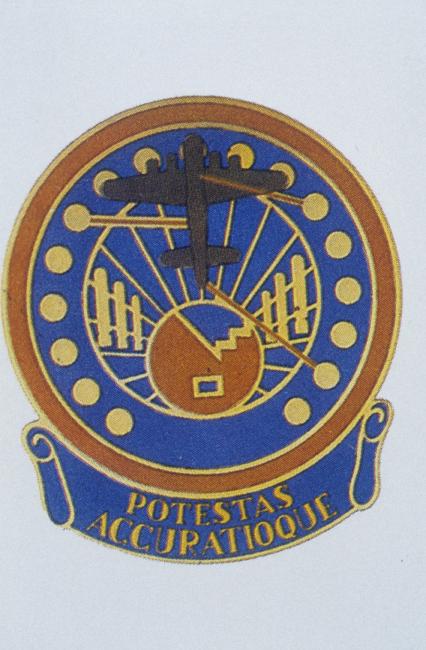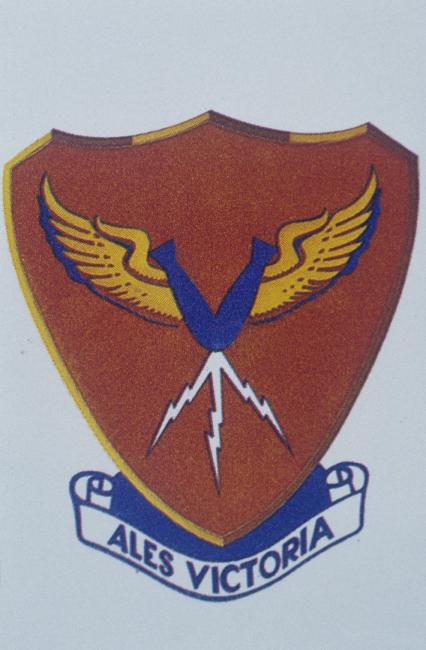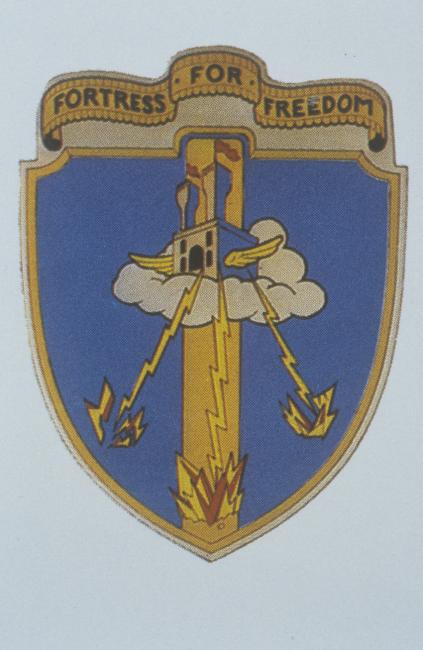VIII Bomber Command 91
6 September 1943![A B-17 Flying Fortress nicknamed "Kicking Horse" of the 303rd Bomb Group takes off with a feathered engine. Handwritten caption on reverse: ''Kicking Horse' of 303BG. Received 7/7/1944.' On reverse: Daily Graphic [Stamp, ref. no. M4226L].](https://assets.americanairmuseum.com/s3fs-public/freeman/media-407628.jpg)
The caption above is incorrect. There was no "Kicking Horse" in the 303rd BG. The plane is actually B-17F 42-5483 "Red Ass." This photo was taken 6 September 1943 as the plane returned from 303rd BG Mission #67 to Stuttgart, Germany.
Radio operator Eddie Deerfield wrote in his notes:
"Our B17F was Red Ass (42-5483) piloted by Robert Cogswell. A 20mm hit by an enemy fighter knocked out our number 1 engine about 15 minutes after leaving the target. We landed with the prop feathered."
Roger Freeman Collection
Gary L Moncur
303rd BG Historian
Object Number - FRE 4241 - A B-17 Flying Fortress nicknamed "Kicking Horse" of the 303rd Bomb Group takes off with a feathered engine. Handwritten caption on reverse: ''Kicking...
Description
This mission was planned as massive attack of 338 B-17s on the industrial areas of Stuttgart, Germany and would be supported by a formation of 69 B-24s flying a diversion. This would be the first action from the UK for the B-24 Groups that had recently returned from Temporary Duty (TDY) assignments to North Africa. The bomber formations would be escorted as far as possible by 176 P-47s. This was the first deep penetration of Germany since the fateful Schweinfurt/Regensburg mission of 17-Aug-43. The round trip distance from the East Anglia bases of the 8th Air Force to Stuttgart would be close to 1,300 miles. This was very close to the maximum range for those B-17s that had not been equipped with the long-range "Tokyo Tanks" and this fact would have disastrous consequences for this mission. It was a gamble.
The first element from 1st Bomb Wing was a formation of 181 B-17s from: 91BG (16); 92BG (21); 303BG (19); 305BG (20); 306BG (21); 351BG (23); 379BG (19); 381BG (21); and 384BG (21). The primary target was Stuttgart, Germany. Many of the B-17s in this formation would be "pushing" their maximum range. Everything would have been fine, except "Mother Nature" bought cloud cover over most of NW France and Germany that day. As a consequence the formation became disorganized and separated and the 151 that were effective from this formation bombed various Targets of Opportunity. This made them extremely vulnerable to fighter attack and difficult for the P-47s to cover. 27 aircraft were lost from this formation; 20 because they ran out of gas on the return and were forced to ditch in the English Channel or make forces landings in the fields of England; 3 others managed to make it to Switzerland and were interned with their crews - 16KIA 64POW 44EVD 116RTD (rescued by Air-Sea Rescue and magnificent accomplishment) 30INT; 13 airmen were Wounded in Action (WIA) and 47 aircraft were damaged.. Freeman cites 9 aircraft declared as Category E (Damaged Beyond Repair) losses but only 5 were actually documented for this raid -50RTD. The bomber gunners claimed 32-6-21 of attacking enemy aircraft (exaggerated).
The second element was a combined force of 157 B-17s from: 95BG (23); 100BG (21); 390BG (24); 94BG (21); 96BG (21); 385BG (23); and 388BG (24) dispatched to Stuttgart. This element had somewhat better success but took more punishment from enemy aircraft. 111 of these aircraft managed to bomb at either Stuttgart or other Targets of Opportunity (TO). 18 aircraft Failed to Return (FTR) but three of these managed to make it to Switzerland and the aircraft and crews were interned - 39KIA 84POW 18EVD 10RTD (rescued by ASR) 29 interned; 1 aircraft was DBR-10RTD. In addition 2 airmen were KIA and 13 wounded in aircraft that returned to England. 69 aircraft were damaged. The bomber gunners in this element claimed 66-14-29 of attacking enemy aircraft (exaggerated).
The third element was a formation of 69 B-24s from: 44BG (18); 93BG (18); 399BG (15); and 392BG (18). 9 aircraft had to abort the mission due to mechanical failures. There are no losses or claims in this element.
Mission Details
Description: BOMB TARGETS OF OPPORTUNITY
Aircraft Type: B-17 Flying Fortress
Notes: Formations become separated because of heavy clouds. German defences take a heavy toll. Mission considered a fiasco. Of the 12 B-17s that ditched in the sea, all crews (116 men) were rescued.

- Unit Hierarchy: Group
- Air Force: Eighth Air Force
- Type Category: Bombardment

- Unit Hierarchy: Group
- Air Force: Eighth Air Force
- Type Category: Bombardment

- Unit Hierarchy: Group
- Air Force: Eighth Air Force
- Type Category: Bombardment

- Unit Hierarchy: Group
- Air Force: Eighth Air Force
- Type Category: Bombardment

- Unit Hierarchy: Group
- Air Force: Eighth Air Force
- Type Category: Bombardment
Mission Statistics
- Tonnage Dropped: 348.90
- People killed in action: 14
- People wounded in action: 14
- People evaded: 42
- Prisoners of war: 66
- People interned: 41
- People returned to duty: 193
- Enemy aircrafts destroyed by bomber: 32
- Enemy aircrafts probably destroyed by bomber: 6
- Enemy aircraft damaged by bomber: 21
- Aircraft sent: 181
- Aircraft effective: 151
- Aircraft missing in action: 27
- Aircraft damaged beyond repair: 9
- Aircraft damaged: 47
Description: DIVERSION
Aircraft Type: B-24 Liberator
Notes: B-24s fly the diversion, 392nd Bomb Group flies its first mission. First mission for B-24s of 44th Bomb Group and 93rd Bomb Group since return from North Africa.

- Unit Hierarchy: Group
- Air Force: Eighth Air Force
- Type Category: Bombardment

- Unit Hierarchy: Group
- Air Force: Eighth Air Force
- Type Category: Bombardment

- Unit Hierarchy: Group
- Air Force: Eighth Air Force
- Type Category: Bombardment

- Unit Hierarchy: Group
- Air Force: Eighth Air Force
- Type Category: Bombardment
Mission Statistics
- Aircraft sent: 69
- Aircraft effective: 60
Description: AIRCRAFT FACTORY/BALL BEARING PLANT
Aircraft Type: B-17 Flying Fortress
Notes: Primary obscured by heavy cloud cover. This hampers mission and many bomb targets of opportunity. Many of the aircraft in this group did not have long-range tanks and as a result ran out of gas and had to ditch or crash-land (reason for 11 Missing in Action (MIA) in 388th Bomb Group). Only one classed as a Damaged Beyond Repair (DBR) - Group designation not in source data. The Stuttgart Mission on 6 September 1943 was disastrous. For the 388th BG this was the worst day and became known as Black Monday. 21 crews were sent and only 13 returned. All 6 aircraft of the 563rd BS were lost. This was Mission #19 (barely 2 months into the war for the 388th BG) and there were 287 more combat missions to go for the 388th BG.
![Three airmen of the 100th Bomb Group, Lieutenant Kenneth Menzie, Lieutenant Donald Strout and Lieutenant Norman Scott, plan the route they will take during the next mission in their B-17 Flying Fortress (serial number 42-30380). Image stamped on reverse: 'Reviewed and passed U.S. Army 23 Aug 1943 Press Censor E.T.O. U.S.A.' [stamp]'. Passed for publication 23 August 1943 INTLD 16 General Section Press Censorship Bureau '[stamp], 'Associated Press' [stamp] and '280035.' [Censor no.] Printed caption on reve](https://assets.americanairmuseum.com/s3fs-public/styles/max_650x650/public/freeman/media-378743.jpg?itok=oPPVVi6c)
- Unit Hierarchy: Group
- Air Force: Eighth Air Force
- Type Category: Bombardment

- Unit Hierarchy: Group
- Air Force: Eighth Air Force
- Type Category: Bombardment

- Unit Hierarchy: Group
- Air Force: Eighth Air Force
- Type Category: Bombardment

- Unit Hierarchy: Group
- Air Force: Eighth Air Force
- Type Category: Bombardment

- Unit Hierarchy: Group
- Air Force: Eighth Air Force
- Type Category: Bombardment
Mission Statistics
- Tonnage Dropped: 391.50
- People killed in action: 41
- People wounded in action: 13
- People evaded: 18
- Prisoners of war: 84
- People interned: 29
- People returned to duty: 10
- Enemy aircrafts destroyed by bomber: 66
- Enemy aircrafts probably destroyed by bomber: 14
- Enemy aircraft damaged by bomber: 29
- Aircraft sent: 157
- Aircraft effective: 111
- Aircraft missing in action: 18
- Aircraft damaged beyond repair: 1
- Aircraft damaged: 69
Connections
See how this entry relates to other items in the archive by exploring the connections below.
People
- Military/Civilian/Mascot: Military
- Nationality: American
- Unit: 381st Bomb Group 534th Bomb Squadron
- Service Numbers: 39398025
- Highest Rank: Staff Sergeant
- Role/Job: Tail Gunner
- Military/Civilian/Mascot: Military
- Nationality: American
- Unit: 92nd Bomb Group 407th Bomb Squadron
- Service Numbers: 18060237 at enlistment, then O-659631
- Highest Rank: First Lieutenant
- Role/Job: Pilot

- Military/Civilian/Mascot: Military
- Nationality: American
- Unit: 388th Bomb Group 561st Bomb Squadron
- Service Numbers: 37111609
- Highest Rank: Technician Fourth Grade
- Role/Job: Waist Gunner

- Military/Civilian/Mascot: Military
- Nationality: American
- Unit: 92nd Bomb Group 407th Bomb Squadron
- Service Numbers: 11998665 /O-674111
- Highest Rank: Second Lieutenant
- Role/Job: Navigator

- Military/Civilian/Mascot: Military
- Nationality: American
- Unit: 351st Bomb Group 510th Bomb Squadron
- Service Numbers: 32478396
- Highest Rank: Staff Sergeant
- Role/Job: Tail Gunner
Aircraft

- Aircraft Type: B-17 Flying Fortress
- Nicknames: Mizpah II/ Frisco Jinny
- Unit: 91st Bomb Group 322nd Bomb Squadron

- Aircraft Type: B-17 Flying Fortress
- Nicknames: Yankee Raider
- Unit: 384th Bomb Group 544th Bomb Squadron 306th Bomb Group 368th Bomb Squadron

- Aircraft Type: B-17 Flying Fortress
- Nicknames: Damn Yankee
- Unit: 384th Bomb Group 545th Bomb Squadron 306th Bomb Group 423rd Bomb Squadron
![Corporal Murray S. Pearl, of the 303rd Bomb Group, with a B-17 Flying Fortress (serial number 41-24565) nicknamed "Idaho Potato Peeler". Image stamped on reverse: ‘Copyright Current Affairs Ltd.’ [stamp], ‘Passed for Publication 28 Jan 1943. [stamp] and ‘245656.’ [Censor no.] Printed caption on reverse: 'Cpl. Murray S. Pearl, serving with the U.S.A.A.F in a bomber squadron, appreciates the heavy fur-lined jerkin issued to him, for, in private life, he was a fur manufacturer at 222 West 28th Stre](https://assets.americanairmuseum.com/s3fs-public/styles/max_650x650/public/freeman/media-378885.jpg?itok=dd2BVzAN)
- Aircraft Type: B-17 Flying Fortress
- Nicknames: The Ramblin' Wreck : Idaho Potato Peeler
- Unit: 303rd Bomb Group 359th Bomb Squadron

- Aircraft Type: B-17 Flying Fortress
- Nicknames: Hell's Angels
- Unit: 303rd Bomb Group 358th Bomb Squadron
Revisions
Lee Cunningham 31-May-2015. Added bomber gunner claims to Stuttgart statistics per "The Mighty Eighth War Diary", Roger A. Freeman.
Lee Cunningham 31-May-2015. Added bomber gunner claims to 1BD TO statistics per "The Mighty Eighth War Diary", Roger A. Freeman.
Lee Cunningham 31-May-2015. Added Mission Narrative based on "The Mighty Eighth War Diary", Roger A. Freeman.
Information sent by Dick Read relating to Arthur M. Read and the 388th Bomb Group.
Lee Cunningham, 8th Air Force missions research database / Stan Bishop's 'Losses of the US 8th and 9th Air Forces', the Combat Chronology of the US Army Air Forces and the work of Roger Freeman including the 'Mighty Eighth War Diary'.
![A B-17 Flying Fortress nicknamed "Kicking Horse" of the 303rd Bomb Group takes off with a feathered engine. Handwritten caption on reverse: ''Kicking Horse' of 303BG. Received 7/7/1944.' On reverse: Daily Graphic [Stamp, ref. no. M4226L].](https://assets.americanairmuseum.com/s3fs-public/styles/max_650x650/public/freeman/media-407628.jpg?itok=2XWNIY5H)
![A B-17F Flying Fortress (SO-S, serial number 42-5843) nicknamed "Black Ghost" of the 547th Bomb Squadron, 384th Bomb Group. Handwritten caption on reverse: 'B-17F-25-VE "Black Ghost" 42-5483 SO*S, 547BS 384BG. Lost Sept 6. 1943, R. Pulcipher crew.' On reverse: From Tim Bivens Collection [Stamp].](https://assets.americanairmuseum.com/s3fs-public/styles/max_650x650/public/freeman/media-413575.jpg?itok=BV_Z9J2o)




